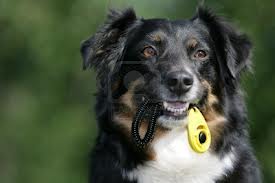Why clicker training?
What is clicker training and why is it different?
‘Normal’ or ‘conventional’ training takes many different approaches but includes:
- “do it because I say so” – getting the dog to work out of fear
- “handling the dog into position (like pushing their bottom to the ground to make them sit)
- “using treats to get what you want – by showing the dog the treat to get them to comply or follow the food
Yes these can all work… Despite having a different approach behind them – fear, handling, reward –they share common ground. This is that this training happens to the dog – the dog isn’t part of the ‘training conversation’ where the dog can chose what to offer and learn what is ‘right’.
How is clicker training different?
It acts like a conversation between you both since the dog sees it as a game where they try to earn rewards from you by working out what you want – therefore the dog plays an active role in the training session rather than being ‘lured’ with food or manhandled into position. This is about real learning.
The dog has to use his brain to think about what he is being rewarded for – he tries out various behaviours from his repertoire and then when the one we want him to repeat gets offered, we click and then reward him. The reward acts as a reinforcer to encourage the behaviour to happen again.
Dogs learn by working out what is rewarding – even if we inadvertently reward the wrong things. So, touching your dog when he jumps up at you is rewarding him for jumping and actually reinforces the behaviour. Or, you could reward him for doing something other than jumping up – doesn’t have to be sitting, it could just be keeping all 4 paws on the floor. The clicker allows you to pinpoint the exact moment that the dog gets it right. This makes it far quicker for the dog to work out what you want.
Sure you could just say “good dog” when he doesn’t jump up, but the pitch of how it is said will vary in different members of your family, which makes it harder for the dog to figure out. You could just give him a treat for not jumping, but lots of dogs will jump up to get the treat and thus this actually rewards jumping….
Will I need to click everything forever?
No – this is a common misunderstanding about clicker training. You only use the clicker to teach your dog a particular behaviour. Once he demonstrates that he understands what you want – by repeating the same behaviour over and over again, you give it a name (such as “sit” and a hand signal). Then you can stop using the clicker and the treats for that particular behaviour.
You use the clicker to teach new things, or to improve and fine-tune behaviours your dog already knows.
I’ve tried it before and it doesn’t work..
We have had a number of people make this comment to us. Think about when you learn to drive a car—if someone told you to turn the steering wheel & press the pedals it wouldn’t mean you could drive!
The key to success lays in understanding how to use the clicker, when to click, when to add the verbal cue and hand signals —and when you fade the use of the clicker.
What can I teach with the clicker?
Absolutely anything the dog is physically and mentally capable of…
Once you have grasped how to use the power of the clicker—you can teach your dog anything—whether to improve his recall, leaving squashed chips or starfish, closing the door, being less reactive to other dogs or bringing you his lead… the world is your oyster!
But I have worked with dogs before – do I need to clicker train?
We have worked with many handlers who are already experienced in conventional dog training… In fact, we were until we started clicker training! We will give you support as you learn the new method – and help you get into new habits of teaching.
It takes time to get to grips with the methodology behind clicker training, but once you understand the method, you can teach anything the dog is capable of. Trust us – once you start there is no going back!
Video clips to show clicker training in action
A cat who has learnt to do agility


